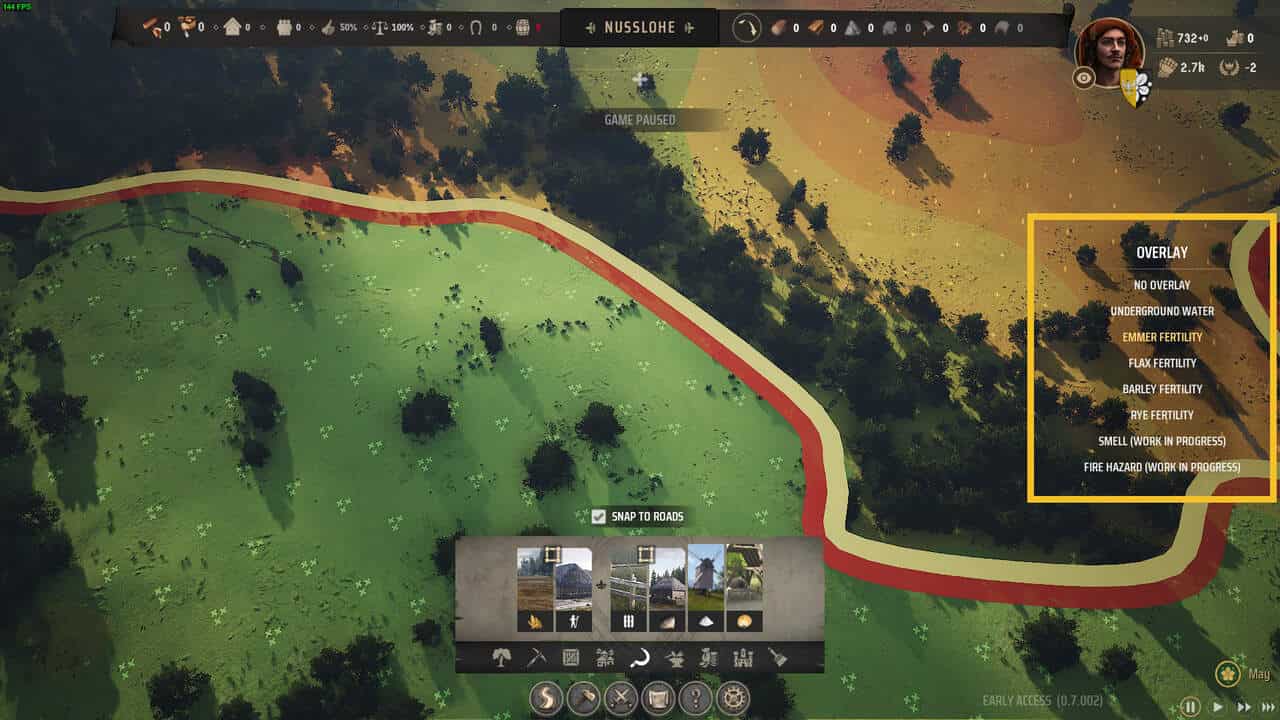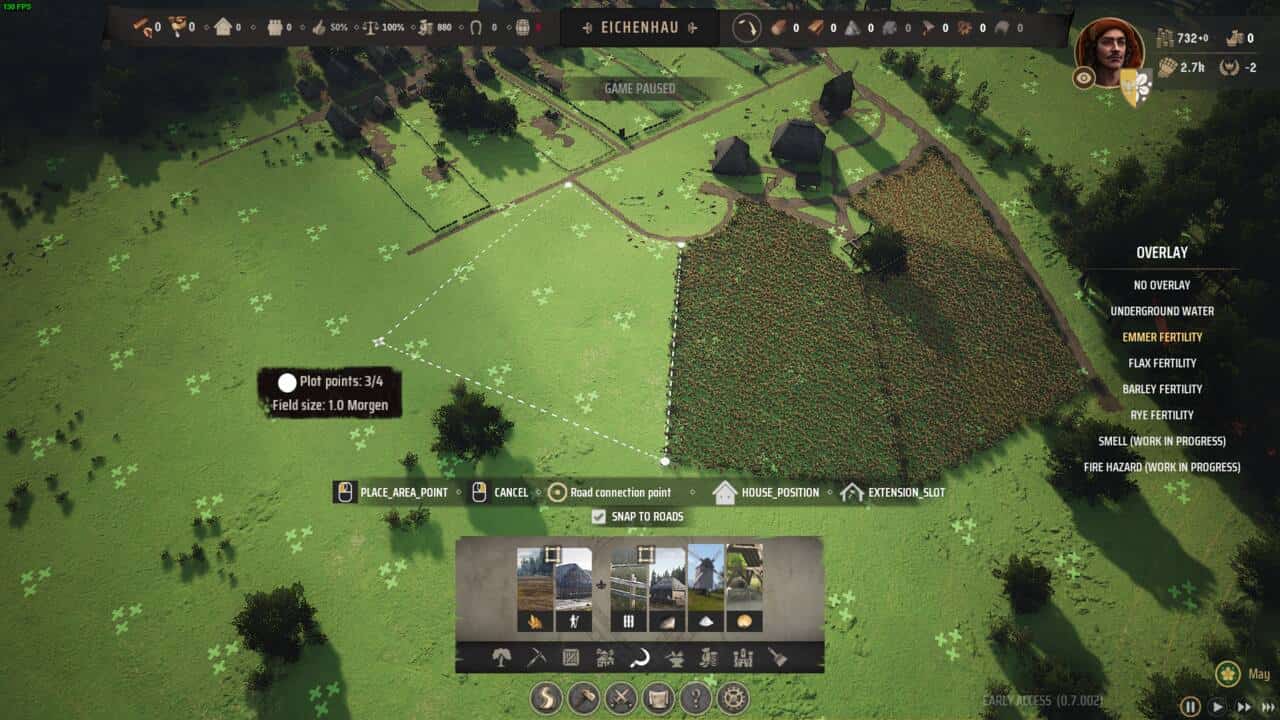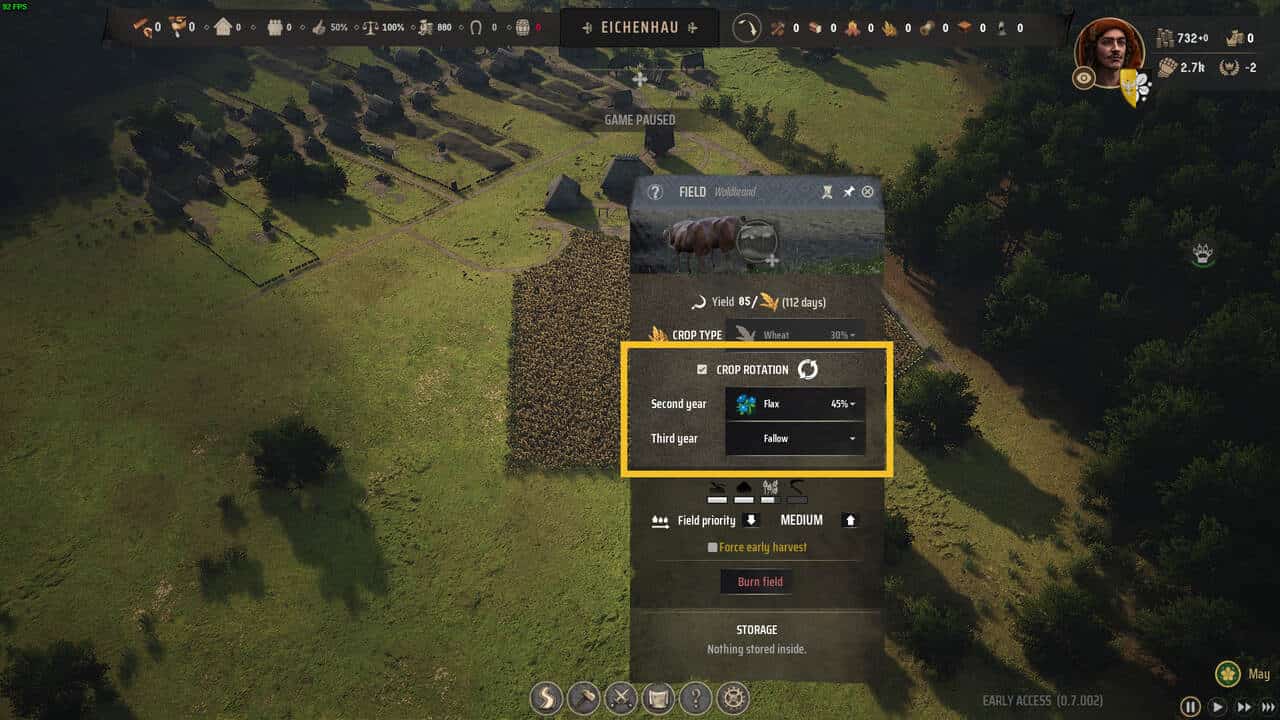Video Gamer is reader-supported. When you buy through links on our site, we may earn an affiliate commission. Prices subject to change. Learn more
Farming in Manor Lords is, in keeping with the game’s heavy lean into realism, complex and somewhat frustrating. There are fields to plot out, soil fertility to consider, mouths to feed, crop rotations to juggle, droughts and weather to manage, and then all the farming adjacent buildings you’ll need to process your crops into Bread, Linen, and Ale.
However you go about playing Manor Lords, you’ll eventually need a robust farming setup to produce the food to support all the new citizens flocking to your settlement. After nearly 60 hours playing Manor Lords, including for our Early Access review, here’s a comprehensive Manor Lords farming guide, full of all the agricultural tips and bucolic nuggets we’ve picked up along the way.
Crop types in Manor Lords
Manor Lords gives you five crop types that you can grow once you’ve plotted out a field and you have a Farmhouse. Here’s a quick brief on the production chain tied to each one and what final product(s) or food they can be turned into:
- Wheat (Emmer) – threshed at the Farmhouse into grain, which is then milled by a Windmill into the Flour needed to bake Bread at a Communal Oven or at Bakery extensions.
- Barley – turned into Malt at a Malthouse, which is then used to brew Ale for your taverns at Brewery extensions.
- Flax – used to produce Linen at the Weaver Workshop, which is then used by the Tailor’s Shop extension to make Clothes, Gambesons, and Cloaks.
- Rye – a more resilient Wheat alternative that is milled into Flour to produce Bread. Unlocked by the Rye Cultivation Development.
- Fallow – signals that no active crop is growing. It’s used to regenerate and recover field soil fertility.

Soil Fertility and overlays
Before plotting out your fields, you’ll want to make sure that the plot of land you’ve chosen has the soil fertility suited to the crop you want to grow. To bring up the heatmap fertility overlays, click on the construction menu toolbar at the bottom of your screen then on the different crop options listed on the right – Emmer Fertility (Wheat), Flax Fertility, Barley Fertility, and Rye Fertility.
If your fertility is looking especially dire at the start of a game, exit and start a new save to reroll your starting position until you land in an area with better soil fertility.
The heatmap goes from green to red, with green offering the best fertility and red the worst. If you look up close, you’ll also spot little + and – symbols. The more + symbols, the better the fertility. Ideally, aim for a green patch with three + symbols for the best fertility for your chosen crop type.

Building a Farmhouse and plotting out Fields
Now you’ve locked in a farming area, you’ll need to build a farmhouse and plot out your fields. You’ll want to build them next to each other so that workers don’t have to travel far when transporting the harvest from the fields to the Farmhouse. There’s space for up to 8 worker families in every Farmhouse and the more you have assigned the faster the fields are tilled, seeded, and harvested. As a general rule, the efficiency sweet spot is about two families per field and a maximum of four actively growing fields (ie. non-fallow) per Farmhouse with 8 families.
A field works like a burgage plot and the marketplace in that it’s a flexible plot where you decide its shape and size by defining four corner plot points. Field size matters and is all about balance; make it too big and workers will struggle to get all the work done, make it too small and you’ll get a pitiful harvest. Manor Lords measures farms in Morgens and you’ll want to aim for roughly 1.0 Morgens for your first field. As your settlement expands and attracts more families to assign to the Farmhouse, you can make your plots much bigger, especially if you unlock farming-focused Developments, but to start, keep them modest.
Click on the field, select what you want to grow under Crop Type. You can also monitor ploughing, sowing, crop growth, and harvest progress here but also the projected yield. There’s also a countdown to harvest. Next to the crop type, you’ll also see a percentage that indicates the field’s fertility status for that particular crop. A higher percentage results in a shorter growing season, so always aim to have the highest percentage possible.
The fertility percentage shown when you first build your field is the maximum fertility that field can have for that type of crop, so you’ll never push it beyond that even with fertility boosting techniques like fallowing and pastures.

Crop rotations and seasons
In the Field window, there’s also the option to set a crop rotation. After every harvest, a field’s fertility drops. To counter this, you’ll want to vary the crops grown year-on-year by introducing a crop rotation. To maximise fertility and yield, never have the same crop growing on the same field two years in a row.
If you have three fields, you can set, for example, the crop type to Wheat, the second year to Flax, and the third year to Fallow for one field, then to Flax/Fallow/Wheat for the second field, and Fallow/Wheat/Flax for the third field. This ensures you get a harvest of Wheat and Flax every year, but also let one field rest fallow to restore fertility.
Farming is also governed by the seasons. Harvesting starts from September and can run up until the end of November so keep this in mind when first building your farms. If you build them in August, they won’t be tilled and sown in time for crops to grow. They’ll lay dormant over winter, but will start growing from March onward. After a year or two, and if the Farmhouse is sufficiently staffed, the typical pattern is workers will have the fields harvested, plowed, and sown before winter, ready for crops to start growing in the spring of the next year, then harvested again in September, and so on.
Best time to start farming in Manor Lords
As tempting as it may be to start farming as soon as possible in Manor Lords, a small starting workforce, limited resources, and the looming winter mean it’s best to wait until the second year to start farming properly. You can survive with just Berries from a Forager Hut and Meat from a Hunting Camp until the next spring quite easily.
To hit the ground running in the second year, you’ll want to build a Farmhouse and 2-3 fields in the Autumn of the first year so that they’re ready to start growing before the late-spring/summer of the next year. All going well, you should have a decent first harvest in September of the second year.
Best farming Developments in Manor Lords
Whenever you hit a new Settlement Level, you’ll unlock Development Points that you can use to unlock new research and upgrades in the Developments tech tree. There’s an entire branch dedicated to crop and livestock farming. Heavy Plow is a must-have that attaches a plowing station to your Farmhouse so you can employ an Oxen to drastically speed up the plowing of fields. It also makes retrieving harvested crops from fields and dropping them off at the Farmhouse much quicker. You can plot out much larger fields with Heavy Plow, increasing your yearly yield.
Fertilization allows you to turn fallow fields into pastures, restoring fertility much faster than if you just left them bare for a year. Rye Cultivation is a handy late game Development, but is in the second tier of the farming branch and is blocked behind Orchardry, a fairly underwhelming tech.
Rye Cultivation, as the name implies, unlocks Rye farming, a much more resilient alternative to Wheat that has less demanding soil fertility needs. It can be milled into Flour like Wheat then turned into Bread. If soil fertility is decent around your settlement, you can forgo this one and instead opt for Sheepbreeding, which passively multiplies the number of sheep grazing on your pasture. An excellent one to pair with Fertilization.
There’s an awful lot to consider when farming in Manor Lords. But dedicate a bit of time to learning its intricacies and you’ll soon be tweaking your way to a farming setup capable of producing a bountiful yield year after year.






